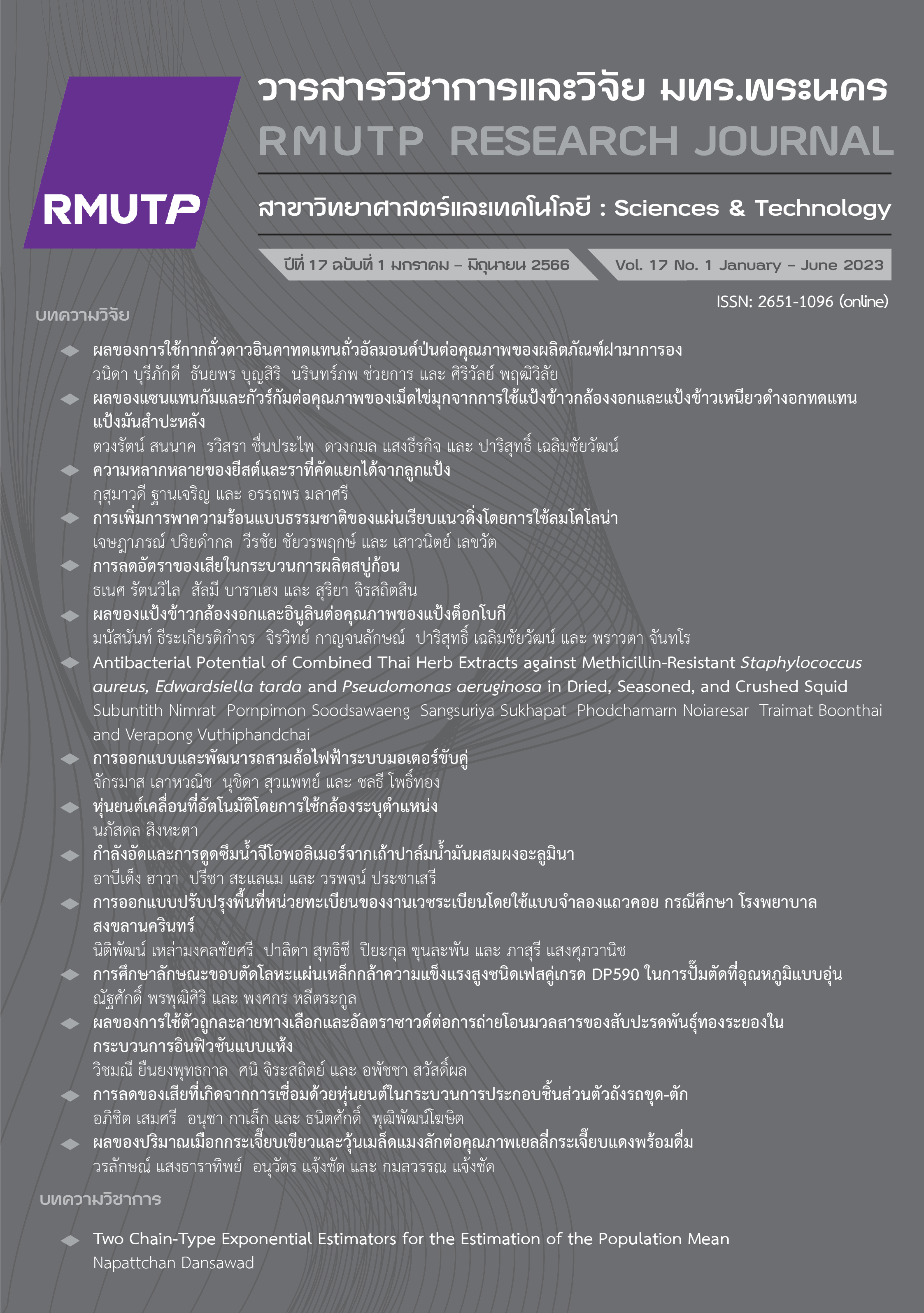Augmentation of Natural Convection of Vertical Plate using Corona Wind
Main Article Content
Abstract
This research investigated the high voltage on natural convection of a vertical flat plate from 5, 6, 7, 8, 9 and 10 kV. The experiment was carried out on a constant heat flux surface in the test section of 1 m width x 1 m length x 1.5 m height. The discharge electrode was installed inside the test section. The discharge electrode is perpendicular to the vertical plate with a distance of 1 cm. Two positions are considered: the center of plate, which corresponds to discharge electrode (position A) and the position above the first position of 2 cm (position B). The effect of high voltage and positions on the plate are considered to enhance heat transfer efficiency. The results show that high voltage of 10 kV can increase the heat transfer enhancement ratio up to 1.06 and 1.03 at position A and B, respectively. The heat transfer efficiency decreases with the decrease of the high voltage. In addition, an accurately predictive formula for the Nussult number under 5-10 kV is also proposed in this paper. Therefore, the obtained experimental results will be important information in order to develop the higher efficiency heat exchangers in the future.
Article Details

This work is licensed under a Creative Commons Attribution-NonCommercial-NoDerivatives 4.0 International License.
ลิขสิทธ์ ของมหาวิทยาลัยเทคโนโลยีราชมงคลพระนครReferences
Energy Policy and Planning Office Ministry of Energy, 2562
The Achievement in Implement of the Government Policy and Industrial Strategy Fiscal Year 2016, Ministry of Industry, 2016.
A. E. Bergles, “The Implications and Challenges of Enhanced Heat Transfer for the Chemical Process Industries,” Chemical Engineering Research and Design, vol. 79, no. 4, pp. 437–444, 2001.
D. H. Shin, S. H. Baek and H. S. Ko, “Development of Heat Sink with Ionic Wind for LED Cooling,” International Journal of Heat and Mass Transfer, vol. 93, pp. 516–528, 2016.
N. E. Jewell-Larsen, H. Ran, Y. Zhang, M. Schwiebert and K. A. Honer, “Electrohydrodynamic (EHD) Cooled Laptop,” in Annual IEEE Semiconductor Thermal Measurement and Management Symposium · April 2009.
I. Y. Chen, M. Z. Guo, K. S. Yang, and C. C. Wang, “Enhanced Cooling for LED Lighting using Ionic Wind,” International Journal of Heat and Mass Transfer, vol.57, pp. 285–291, 2013.
M. Molki and K. L. Bhamidipati, “Enhancement of Convective Heat Transfer in the Developing Region of Circular Tubes using Corona Wind,” International Journal of Heat and Mass Transfer, vol. 47, pp. 4301–4314, 2004.
B. L. Owsenek, J. S. Yagoobi and R. H. Page, “Experimental Investigation of Corona Wind Heat Transfer Enhancement with a Heated Horizontal Flat Plate,” Journal of Heat Transfer, vol. 117, pp. 309-315, 1995.
D. H. Shin, S. H. Baek and H. S. Ko, “Development of Heat Sink with Ionic Wind for LED Cooling,” International Journal of Heat and Mass Transfer, vol. 93, pp. 516–528, 2016.
L. Léger, E. Moreau and G. G. Touchard, “Effect of a DC Corona Electrical Discharge on the Airflow Along a Flat Plate,” IEEE Transactions on industry applications, vol. 38, no. 6, 2002.
J. R. Lee and E. V. Lau, “Effects of Relative Humidity in the Convective Heat Transfer over Flat Surface using Ionic Wind,” Applied Thermal Engineering, vol. 114, pp. 554–560, 2017.
Y. Y. Tsui, T. K. Wei and C. C. Wang, “A Novel Means Combining Corona Discharge and Electrostatic Force-Induced Vibration for Convective Heat Transfer,” Journal of Heat Transfer, Transactions of the ASME 142, 2020.
B. L. Owsenek and J. S. Yagoobi, “Theoretical and Experimental Study of Electrohydrodynamic Heat Transfer Enhancement Through Wire-Plate Corona Discharge,” Journal of Heat Transfer, vol. 119, pp. 604-610, 1997.
R. T. Huang, W. J. Sheu and C. C. Wang, “Heat Transfer Enhancement by Needle-Arrayed Electrodes – An EHD Integrated Cooling System,” Energy Conversion and Management, vol. 50, pp. 1789–1796, 2009.
M. Molki and K. L. Bhamidipati, “Enhancement of Convective Heat Transfer in the Developing Region of Circular Tubes using Corona Wind,” International Journal of Heat and Mass Transfer, vol. 47, pp. 4301–4314, 2004.
D. B. Go, R. A. Maturana, T. S. Fisher and S. V. Garimella, “Enhancement of External Forced Convection by Ionic Wind,” International Journal of Heat and Mass Transfer, vol. 51, pp. 6047–6053, 2008.
T. Stegmaier, A. Dinkelmann, V. V. Arnim and A. Rau, “Corona and Dielectric Barrier Discharge Plasma Treatment of Textiles for Technical Applications,” Plasma technologies for textiles, pp. 129-157, 2007.
A. Yabe, Y. Mori and K. Hijikata, “Active Heat Transfer Enhancement by Utilizing Electric Fields,” Annual Reviews of Heat Transfer, vol. 7, pp. 193-244, 1996.
P. Intra, Aerosol Charging Technology by Electric Field: Theory and Innovation, 2nd Edition, 2560.
F. Yang, “Corona-Driven Air Propulsion for Cooling of Microelectronics,” Thesis, University of Washington, 2002.
Y. A. Cengel and A. J. Ghajar, Heat and Mass Transfer – Fundamentals & Applications. New York: McGraw-Hil, 2015.
R. T. Huang, W. J. Sheu and C. C. Wang, “Heat Transfer Enhancement by Needle-Arrayed Electrodes – An EHD Integrated Cooling System,” Energy Conversion and Management, vol. 50, pp. 1789–1796, 2009.
J.P. Holman, Heat Transfer, 10th ed. New York: McGraw-Hill, 2010.
Y. A. Cengel, Heat and Mass transfer: A practical approach. 3rd ed, McGraw Hill, 2006.


